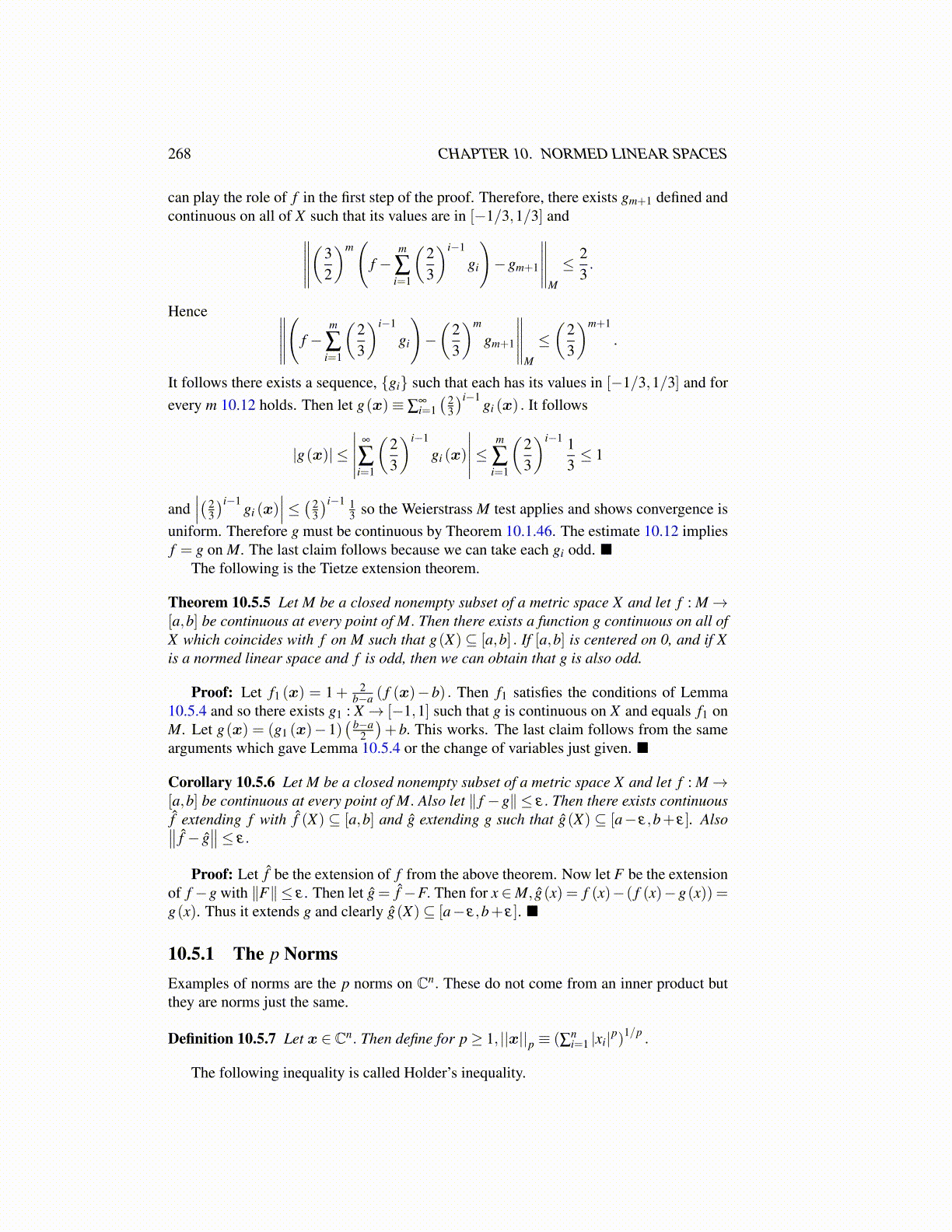
268 CHAPTER 10. NORMED LINEAR SPACES
can play the role of f in the first step of the proof. Therefore, there exists gm+1 defined andcontinuous on all of X such that its values are in [−1/3,1/3] and∥∥∥∥∥
(32
)m(
f −m
∑i=1
(23
)i−1
gi
)−gm+1
∥∥∥∥∥M
≤ 23.
Hence ∥∥∥∥∥(
f −m
∑i=1
(23
)i−1
gi
)−(
23
)m
gm+1
∥∥∥∥∥M
≤(
23
)m+1
.
It follows there exists a sequence, {gi} such that each has its values in [−1/3,1/3] and forevery m 10.12 holds. Then let g(x)≡ ∑
∞i=1( 2
3
)i−1gi (x) . It follows
|g(x)| ≤
∣∣∣∣∣ ∞
∑i=1
(23
)i−1
gi (x)
∣∣∣∣∣≤ m
∑i=1
(23
)i−1 13≤ 1
and∣∣∣( 2
3
)i−1gi (x)
∣∣∣≤ ( 23
)i−1 13 so the Weierstrass M test applies and shows convergence is
uniform. Therefore g must be continuous by Theorem 10.1.46. The estimate 10.12 impliesf = g on M. The last claim follows because we can take each gi odd. ■
The following is the Tietze extension theorem.
Theorem 10.5.5 Let M be a closed nonempty subset of a metric space X and let f : M→[a,b] be continuous at every point of M. Then there exists a function g continuous on all ofX which coincides with f on M such that g(X) ⊆ [a,b] . If [a,b] is centered on 0, and if Xis a normed linear space and f is odd, then we can obtain that g is also odd.
Proof: Let f1 (x) = 1+ 2b−a ( f (x)−b) . Then f1 satisfies the conditions of Lemma
10.5.4 and so there exists g1 : X → [−1,1] such that g is continuous on X and equals f1 onM. Let g(x) = (g1 (x)−1)
( b−a2
)+ b. This works. The last claim follows from the same
arguments which gave Lemma 10.5.4 or the change of variables just given. ■
Corollary 10.5.6 Let M be a closed nonempty subset of a metric space X and let f : M→[a,b] be continuous at every point of M. Also let ∥ f −g∥ ≤ ε. Then there exists continuousf̂ extending f with f̂ (X) ⊆ [a,b] and ĝ extending g such that ĝ(X) ⊆ [a− ε,b+ ε]. Also∥∥ f̂ − ĝ
∥∥≤ ε.
Proof: Let f̂ be the extension of f from the above theorem. Now let F be the extensionof f −g with ∥F∥ ≤ ε . Then let ĝ = f̂ −F. Then for x ∈M, ĝ(x) = f (x)− ( f (x)−g(x)) =g(x). Thus it extends g and clearly ĝ(X)⊆ [a− ε,b+ ε]. ■
10.5.1 The p NormsExamples of norms are the p norms on Cn. These do not come from an inner product butthey are norms just the same.
Definition 10.5.7 Let x ∈ Cn. Then define for p≥ 1, ||x||p ≡ (∑ni=1 |xi|p)1/p .
The following inequality is called Holder’s inequality.